Lately I’ve been having a lot of conversations around investment terms with searchers, as well as investors.
About 15 years ago, I interned at a search fund. And, over the last few years, I’ve started to invest in the asset class going direct as well as through funds of search funds.
Investing in search funds is a great way to scratch my entrepreneurial itch, extremely rewarding when a searcher finds success, and can be economically rewarding too.
This post is my attempt to share thoughts on self funded search economics in an effort to contribute to the search fund community, get feedback on my thinking from a wider audience, and of course meet more people who are doing searches/investing and may want to collaborate (please feel free to reach out!).
You can watch a video of me explaining this model here, and download the excel here:

Enterprise Value
The standard finance equation is enterprise value = debt + stock – cash. Enterprise value is how much the company itself is worth. Many times people confuse it with how much the stock is worth and find the “minus cash” part of this really confusing.
So, you can rearrange this equation to make it stock = enterprise value – debt + cash. Make more sense now?
Enterprise value is just how much you’re willing to pay for the company (future cash flows, intellectual property, etc), not the balance sheet (debt and cash).
Most investors and searchers think about the EBITDA multiple of a company on an enterprise value basis because they’ll be buying it on a cash free, debt free basis. It becomes second nature to think about EBITDA multiples and know where a given business should fall given scale, industry, etc.
However, I believe this second nature way of thinking of things can be a massive disadvantage to investors given the way EV and multiples are talked about in our community currently.
Sources of capital, the typical way to calculate enterprise value for self funded searchers
If you’ve ever looked at or put together a teaser for a self funded search deal, you will notice that the deal value is equal to the sum of the sources of capital minus deal fees and cash to the balance sheet.
As a simple example, if there is $4 mm of debt to fund the deal, $1 mm of equity, and $200k of deal fees, the enterprise value = $4 mm + $1 mm – 200k = $4.8 mm.
We’ll use slightly more complex numbers in our example: If a searcher is taking a $3.2 mm SBA loan, $850k seller note, putting in $120k themselves, getting $350k of equity from the seller, a $500k earnout, and $1.2 mm of equity financing minus $350k to the balance sheet and $250k of deal fees, then the enterprise value will be $5.62 mm.
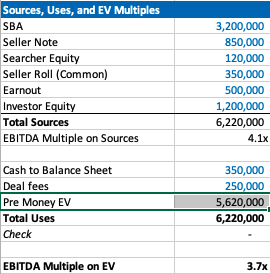
Our example company has $1.5 mm of EBITDA, so the EBITDA multiple is 3.7x. This is a pretty attractive acquisition multiple for a business that meets traditional search criteria (recurring revenues, fragmented competition, high gross margins, low customer concentration, etc).
If you’re seeing a search fund deal for the first time, the headline of “we’re buying a decent company for 3.7x, and replacing a tired owner with a hungry operator” is pretty exciting!
However, if you’re an investor, there is some nuance to this enterprise value number and the true EBITDA multiple you are investing in.
The trick with self funded enterprise value
The security that most self funded search investors get in a deal is participating preferred stock with a paid in kind dividend. This means when there’s an exit, you get your money back before any other equity holder, then get a certain percent of the business, and whatever dividend you’ve been owed in the interim accrues to your principle.
It’s a really favorable security for the investor, and one that is basically impossible to get in VC where straight preferred stock is much more common (no pun intended).
The key terms are what percent of common equity does this security convert into after the originally principal is paid back, and what is the dividend.
The share of common equity the investor group will get typically ranges from 10-50% of the total common stock. The dividend rate is usually 3-15%. The average I’m seeing now is around 30% and 10% for common and dividends respectively.
The strange this about the enterprise value quoted to investors in a teaser/CIM is that it doesn’t change as the percent of common changes, even though this has large implications for how much the common equity is worth and the value investors receive.
For example, I may get a teaser where the sources of investment – cash to balance sheet – deal fees = $3.7 mm for a $1 mm EBITDA company, which would imply a 3.7X EBITDA multiple. Let’s say the searcher is offering investors 30% of the common and a 10% dividend.
Let’s now say that the searcher is having a tough time raising capital and changes their terms to 35% of common and a 12% dividend. Does the effective enterprise value change for investors? I would argue yes, but I would be surprised to see it changed in the CIM/teaser.
This isn’t a knock on searchers or the search fund community. It’s just kind of how things are done, and I think this is mostly because it’s really hard to think about how the enterprise value has changed in this scenario.
However, the natural way of using EBITDA multiples to think about value for a business that is so common in PE/SMB can be extremely misleading for investors here. You may be thinking 3.7X for this type of business is a great deal! But, what if the security you’re buying gets 5% of the common?
If you’re in our world, you may counter this point by saying most searchers will also supply a projected IRR for investors in their CIM. However, IRR is extremely sensitive to growth rate, margin expansion, and terminal value. While the attractiveness of the security will be reflected, it can be greatly overshadowed by lofty expectations.
To get more clarity and have a slightly different mental model on the effective price investors are paying for this business, let’s go back to basics. Enterprise value should be debt + preferred stock + common stock – cash.
We know the values of each of these numbers, except the common. So, the main question here becomes: how much is the common equity worth?
Calculating value of common equity for self funded search funds
Equity value for most search fund deals = preferred equity from investors + the common equity set aside for the searcher and sometimes also advisors, board, seller.
We know that the preferred equity is investing a certain amount for a certain amount of common equity. The rub is that they are also getting a preference that they can take out before any common equity gets proceeds, and they are getting a dividend.
So, the exercise of valuing the common equity comes down to valuing the preference and dividend.
In my mind, there are three approaches:
- The discount rate method where you take the cash flows you’ll get in the future from the pref/dividends and discount them back at the discount rate of your choice. I am using 30% in my model which I believe accurately compensates investors for the risks they are taking in a small, highly leveraged investment run by an unproven operator. If you believe in efficient markets, this number also fits as it mirrors the historical equity returns as reported by the Stanford report, with a slight discount given this asset class has clearly generated excess returns relative to other assets on a risk adjusted basis, hence interest in these opportunities from an expanding universe of investors.
- The second method is to calculate how much money you’d get from your preference and dividends, taking into account that per the Stanford study around 75% of search funds will be able to pay these sums, and then discount these cash flows back at a rate more in line with public equities (7% in my model). This yields a much higher value to the preference/dividend combo, and therefore lowers the implied value of the common equity.
- The last method is to just say nope, there is no value to the preference and dividend. I need them and require them as an investor, but they are a deal breaker for me if they aren’t there, and therefore they don’t exist in my math. This of course makes no logical sense (you need them, but they also have no value?), but I’ve left it in as I think many investors probably actually think this way and it creates a nice upper bound on the enterprise value. Side note, as with obstinate sellers, jerk investors are usually best avoided.
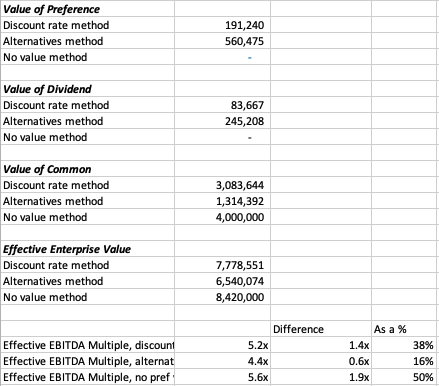
In our example, you can see a breakdown of the preference value, dividend value, and therefore common value and enterprise value for this deal.
In each case, the effective EBITDA multiple moves from 3.7x to something much higher (see the last 3 lines).
There are some simplifying assumptions in the model (no accruing dividend, all paid in last year), and some weird stuff that can happen (if you make the hold time long and the dividend greater than the 7% equity discount rate, the value of the dividend can get really big).
These flaws aside, I think this creates a nice framework to think through what the common is actually worth at close, and therefore what enterprise value investors will be paying in actuality.
It’s worth noting that the whole point of this is to benchmark the value you’re getting relative to market transactions in order to understand where you want to deploy your capital.
This creates a method to translate cash flow or EBITDA multiples of other opportunities on an apples to apples basis (if only there were a magical way to translate the risk associated with each as well!).
Another note, we could calculate the value of the common to be what this asset would trade at market today in a well run auction process minus any obligations (debt, preference, seller financing). However, I think that understates the option value inherent in this equity, a value that is only realized when a new manager takes over with more energy and know how.
There is a finance nerd rational for this. If you plot the value of equity in a leveraged company on a chart, it mirrors the payout of a call option. In both cases, the value of the security increases at a certain inflection point: when the value of equity rises above the strike price in an option, and when the enterprise value of a company rises above the debt level in a levered company.
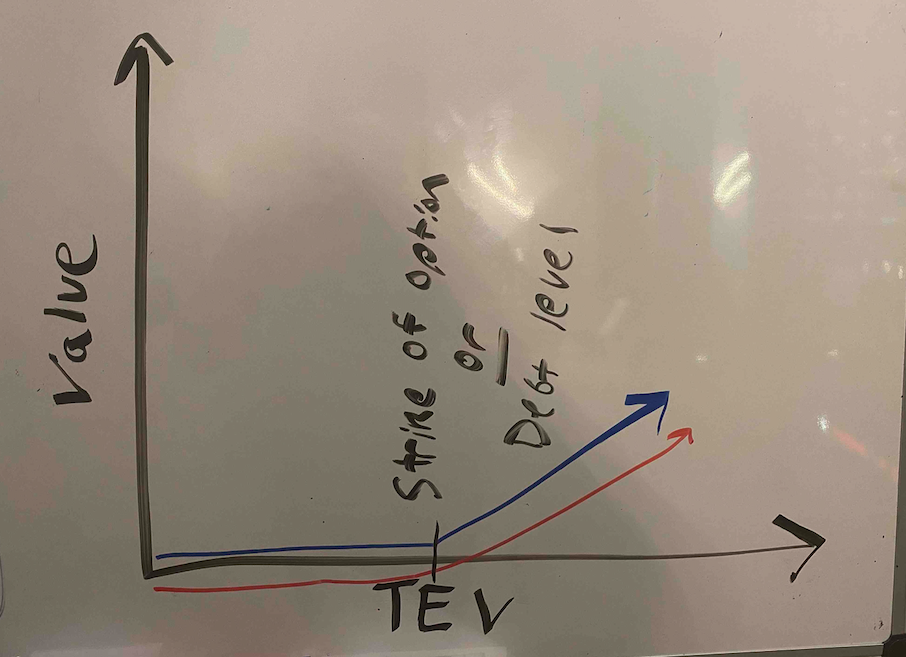
The common equity of a highly levered company can therefore be valued by a similar methodology as the call option: Black Scholes. If you remember back to finance class, increasing volatility will increase the value of an option.
In the search fund case, we’ve (hopefully) increased the (upside) volatility and therefore create more value than simply selling the company today.
A few more thoughts on investor economics
There are a few other ways to think about the economics you get as an investor to best understand if this is the deal for you.
First, you may want to think about how much your investment will be worth day 1. The key lever in this model is what discount this company is being bought for relative to fair market value. For example, the searcher may have proprietary sourced a great company and is buying it for 25% below what it would trade at in a brokered auction.
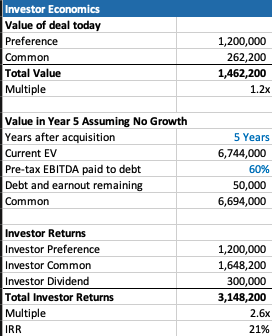
This is very much a “margin of safety” philosophy on things. Same with the calculation on how much you’ll receive in year 5 (after QSBS hits) assuming no growth in the business.
The only problem with each of these calculations is that they never play out in practice. Most companies don’t just stay the same, you’re either in a rising tide or you’re in trouble. And, you’re almost never going to sell in year 1, and definitely not for a slight premium to what it was bought for.
However, if your investment is worth 30% higher day one, and you can make a 20% IRR assuming nothing too crazy happens either way in the business, that’s not a bad place to start. Add in a strong searcher, decent market, some luck, and you’re off to the races.
Thoughts on searcher economics
A lot of this post has considered things from the investor perspective as my main quandary was related to how to create an EBITDA multiple that made sense for investors.
However, the point of this post is not to say searchers are misrepresenting or being unrealistic with their terms. In fact, I think it’s quite logical that self funded searchers capture the massive economic value that they do.
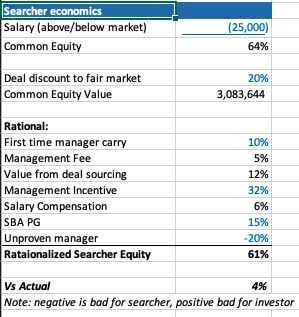
There are many reasons why self funded searchers deserve the lion share of the common equity.
First, they are providing a nice service of giving investors a positive expected value home to park their money with much lower correlation to the market than other asset classes ($1 mm EBITDA companies don’t see lots of multiple contraction/expansion throughout cycles).
Most money managers that fit that criteria are taking a 2/20, of course they also usually have a track record. So, I’ve used a 10% carry in my model, but stuck to 2% annual management fee.
The searcher spent a lot of time, and probably money, finding this company. That’s a lot of value, especially if it’s a below market price. They should be able to capture a lot of the value in finding a below market deal.
The searcher may be taking a below market salary, and needs to get comped like any CEO, with stock options. In my example model I have $1 mm of stock vesting over the hold period, as well as extra comp for taking a below market salary.
Searchers are also usually putting their financial standing at risk by taking a personal guarantee on the bank/SBA loan. This is really tough to put a number on, as is the last line in my framework where searchers are dinged for lack of experience. Like any good model, you need a few lines that you can fudge to make the math work 🙂
What you do think?
I’m shocked that I wrote all this. I was going to type a few paragraphs and a quick excel. However, putting this to paper has been a great exercise for me to sharpen my thinking.
Now I’d like you to help me further. Where do you think this should be changed in this framework? How do you think about things from the investor and/or searcher side?
Feel free to shoot me a note if you have thoughts (even just to tell me I’m being way too academic with this, which I actually agree with).
Lastly, a post like this is really a trap I’m putting on the internet to catch any like minded people in so that we can figure out ways to collaborate now or in the future. So, at the very least, connect with me on LinkedIn 🙂
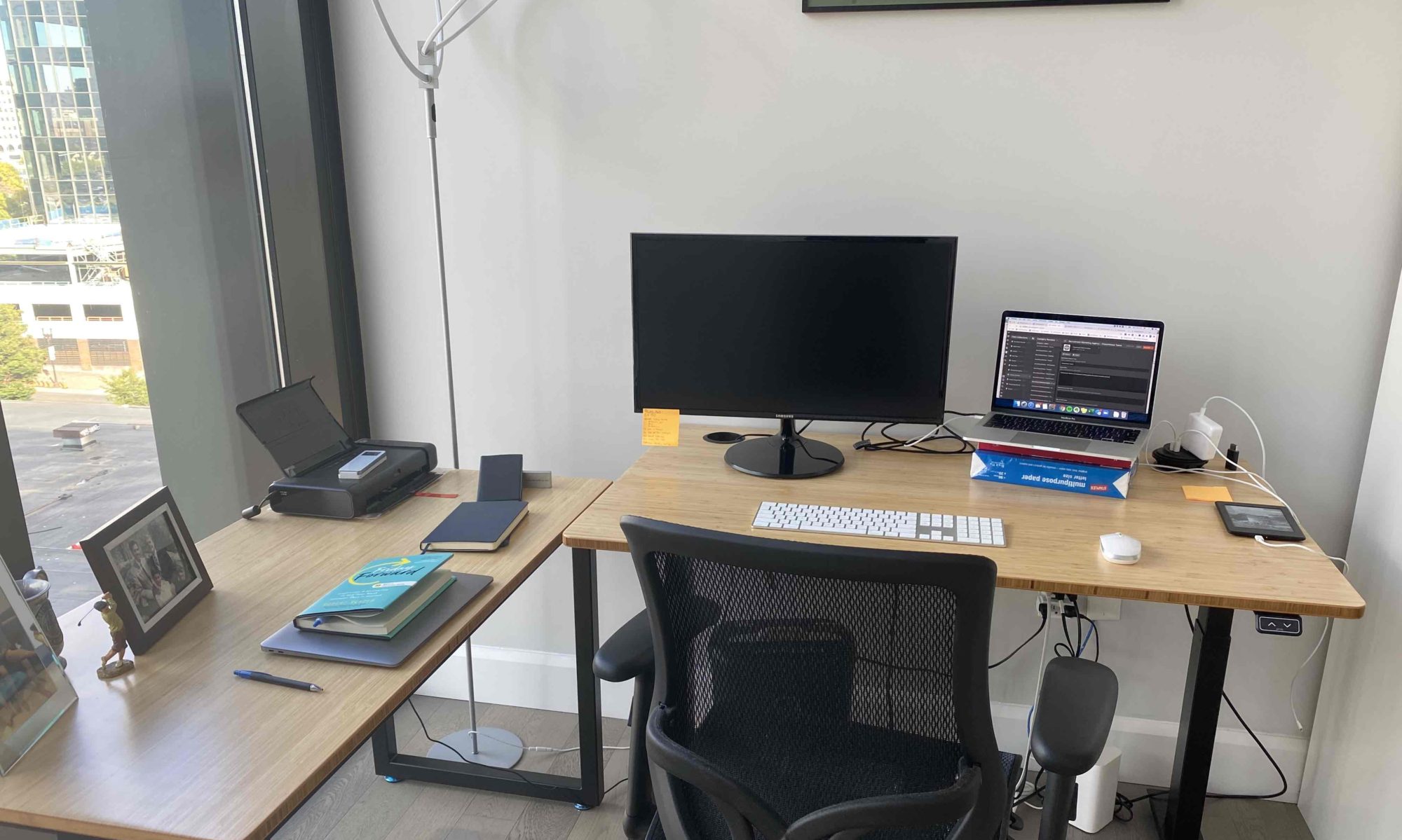
Your website has certainly furnished me personally with
only the data that I required. I currently have been undertaking exploration upon this subject matter for a time, and
this has taken a very long while to discover a blog page that gives all of the details that I will need.
I search forward to studying more blogs authored by you
in the future, and might seek here initially
the very next time I just have got another research requirement. https://njmassages.com/
Hi there to every one, the contents present at this site are truly awesome for
people experience, well, keep up the nice work fellows.
continuously i used to read smaller content which also clear their motive, and that is also happening with
this piece of writing which I am reading now.
Right here is the right web site for anyone who
hopes to understand this topic. You realize so much its almost hard
to argue with you (not that I actually would want to…HaHa).
You certainly put a new spin on a subject that’s been discussed for ages.
Excellent stuff, just wonderful!
Hello! I know this is kind of off-topic but I needed to ask.
Does managing a well-established website like yours require a massive amount work?
I’m completely new to operating a blog however I do write in my
diary daily. I’d like to start a blog so I will be able to
share my own experience and feelings online. Please let me know if you have any recommendations or tips for
new aspiring bloggers. Appreciate it!
Hi, I do think this is an excellent blog. I stumbledupon it 😉 I will return yet again since
I bookmarked it. Money and freedom is the greatest way to change, may you be rich and continue to
guide other people.
Pretty great post. I simply stumbled upon your weblog and wanted to say that I’ve really loved browsing your weblog
posts. In any case I’ll be subscribing in your feed and I am hoping you write once more very soon!
My programmer is trying to convince me to move
to .net from PHP. I have always disliked the idea because of the expenses.
But he’s tryiong none the less. I’ve been using
Movable-type on numerous websites for about a year and am anxious about switching to another platform.
I have heard good things about blogengine.net. Is there a way I can transfer all my wordpress content into it?
Any kind of help would be really appreciated!
When some one searches for his required thing, so he/she
desires to be available that in detail, thus
that thing is maintained over here.
you’re in point of fact a good webmaster.
The site loading pace is incredible. It kind of feels that
you’re doing any unique trick. In addition, The contents are masterwork.
you have done a wonderful task in this subject!
This website truly has all of the info I needed concerning
this subject and didn’t know who to ask.
I always spent my half an hour to read this blog’s posts daily
along with a cup of coffee.
Thanks for a marvelous posting! I seriously enjoyed reading it, you
are a great author.I will always bookmark your blog and will come back in the future.
I want to encourage you to continue your great posts, have a
nice weekend!
Howdy I am so grateful I found your weblog, I really found
you by mistake, while I was looking on Bing for something else,
Nonetheless I am here now and would just like to say thank you for a tremendous post
and a all round entertaining blog (I also love the theme/design), I don’t have time to read through it
all at the moment but I have book-marked it and also added your RSS feeds, so
when I have time I will be back to read more, Please do keep up the excellent work.
This post is invaluable. When can I find out more?
Appreciate the recommendation. Let me try it
out.
These are in fact impressive ideas in concerning blogging.
You have touched some good factors here.
Any way keep up wrinting.
whoah this blog is great i like reading your articles.
Keep up the great work! You realize, a lot of individuals are hunting around
for this info, you can help them greatly.
I loved as much as you will receive carried out right here.
The sketch is tasteful, your authored subject matter stylish.
nonetheless, you command get got an shakiness
over that you wish be delivering the following. unwell unquestionably come more formerly again as exactly the same nearly a lot often inside
case you shield this increase.
Wow, fantastic blog layout! How long have you been blogging for?
you make blogging look easy. The overall look of your web
site is wonderful, let alone the content!
Hello, i think that i saw you visited my blog
thus i came to “return the favorâ€.I am attempting to find things to improve my web site!I suppose its ok to use a few of your ideas!!
Greetings! Very useful advice in this particular post!
It is the little changes that make the largest changes.
Thanks a lot for sharing!
Hello, Neat post. There is an issue with your site in web explorer, might check this?
IE still is the marketplace leader and a good component of
people will miss your magnificent writing due to this problem.
I don’t even know how I ended up here, but I
thought this post was great. I do not know who you are but
certainly you are going to a famous blogger if you aren’t already 😉 Cheers!
I needed to thank you for this good read!! I absolutely enjoyed every bit of
it. I’ve got you saved as a favorite to look at new stuff
you post…
I’m amazed, I have to admit. Rarely do I come across a blog that’s equally educative and amusing, and
without a doubt, you’ve hit the nail on the head. The problem is something that not enough
people are speaking intelligently about. Now i’m very happy I stumbled across this in my search for something
relating to this.
I am regular reader, how are you everybody?
This piece of writing posted at this site is genuinely good.
Hey I am so excited I found your blog, I really found
you by error, while I was browsing on Digg for something else, Regardless I am here now and would just like to
say cheers for a incredible post and a all round exciting blog (I also love the theme/design), I don’t have time to read it all at
the moment but I have saved it and also added in your RSS feeds, so when I have time I will
be back to read a lot more, Please do keep up the excellent work.
Excellent article. I will be facing a few of these issues as well..
Very nice article, exactly what I was looking for.
Hi, the whole thing is going nicely here and ofcourse every one is sharing facts, that’s really fine, keep
up writing.
Hey there exceptional website! Does running a blog similar to this require a
massive amount work? I’ve very little expertise in computer programming however I was
hoping to start my own blog soon. Anyways, should you have any suggestions or tips for new
blog owners please share. I understand this is off subject but I simply wanted to ask.
Kudos!
Hi, I do think this is an excellent web site. I stumbledupon it 😉 I am going to revisit once again since i
have saved as a favorite it. Money and freedom is
the best way to change, may you be rich and continue to help other
people.
Today, I went to the beach front with my children. I found a sea shell and gave it to my 4 year old daughter and said
“You can hear the ocean if you put this to your ear.” She placed
the shell to her ear and screamed. There was a hermit crab inside and it pinched her ear.
She never wants to go back! LoL I know this is entirely off
topic but I had to tell someone!
Hurrah! Finally I got a webpage from where I can truly obtain helpful information regarding my study and knowledge.
I constantly spent my half an hour to read this weblog’s articles every day along with a mug of coffee.
It’s a pity you don’t have a donate button! I’d most certainly donate to this excellent blog!
I guess for now i’ll settle for book-marking and adding your RSS feed to my Google account.
I look forward to brand new updates and will talk about this blog with
my Facebook group. Chat soon!
I’d like to find out more? I’d like to find out some additional information.
You actually make it seem so easy with your presentation but I find this matter
to be really something that I think I would never understand.
It seems too complex and very broad for me. I’m looking forward for your next
post, I will try to get the hang of it!
I have been exploring for a bit for any high quality articles or blog posts in this sort of space .
Exploring in Yahoo I ultimately stumbled upon this
web site. Studying this info So i’m satisfied to show that I’ve a very excellent uncanny feeling I
discovered exactly what I needed. I most surely will make sure to
do not overlook this web site and provides it a look regularly.
Thank you for the auspicious writeup. It in fact was a amusement
account it. Look advanced to more added agreeable
from you! By the way, how can we communicate?
This article offers clear idea in favor of the new
viewers of blogging, that in fact how to do running
a blog.
It’s difficult to find knowledgeable people on this subject,
but you sound like you know what you’re talking about!
Thanks
Everything is very open with a really clear description of
the issues. It was definitely informative. Your
site is very useful. Many thanks for sharing!
I just couldn’t go away your website before
suggesting that I really enjoyed the usual info an individual
supply to your visitors? Is gonna be again often in order to check out new posts
Quality content is the crucial to invite the visitors to pay a
visit the site, that’s what this web page is providing.
Wow! At last I got a website from where I be capable of in fact
take helpful information concerning my study
and knowledge.
Hello! I just would like to give you a huge thumbs up for the
excellent information you’ve got here on this post. I’ll be coming back to your site for more soon.
Somebody necessarily help to make severely posts I’d state.
This is the very first time I frequented your web page and thus far?
I surprised with the analysis you made to make this
actual submit incredible. Excellent job!
Hi my loved one! I wish to say that this post is amazing,
nice written and include almost all important infos.
I’d like to peer more posts like this .